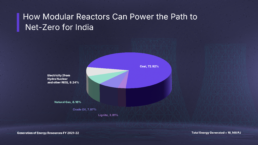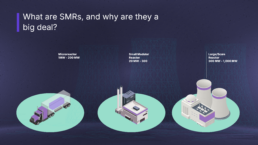India’s path to achieving net-zero emissions by 2070 is strewn with formidable challenges, particularly in transforming its energy infrastructure while meeting the demands of rapid economic growth and urbanization. The nation’s heavy reliance on coal, which currently powers about 70% of its electricity generation, presents a significant hurdle in transitioning to cleaner energy sources.
However, nuclear energy emerges as a promising solution, offering a reliable, carbon-free baseload power source that can complement renewable energy efforts. While India has made substantial progress in its nuclear program, with 23 operational reactors, the traditional large nuclear plants require extensive infrastructure, significant capital investment, and lengthy construction timelines – factors that could potentially slow down the urgent need for clean energy deployment. This is where Small Modular Reactors (SMRs) could play a transformative role in India’s energy landscape.
What are SMRs, and why are they a big deal?
SMRs, as the name suggests, are compact nuclear reactors that are factory-built. They are a scalable solution and typically generate between 20 to 300 megawatts.
SMRs represent a new approach to nuclear power generation that aligns well with India’s decentralised energy needs that arise due to its rural spread. Another important consideration is the country’s geographical distribution – island territories and difficult-to-access remote locations like Himalayas or the Northeastern terrain. As the nation works to balance its ambitious climate goals with its growing energy needs, SMRs offer a promising pathway that could help address both the technical and economic challenges of the energy transition while maintaining grid stability and energy security.
Why SMRs Make Sense for India’s Energy Future?
Soaring Energy Demand
India’s energy needs are projected to grow by 30% by 2040, driven by rapid industrialization and urban expansion (IEA, 2023). Renewables like solar and wind are essential but can’t always keep up with peak demands—especially when the sun isn’t shining or the wind isn’t blowing.
Renewable Challenges
Solar and wind, while promising, face issues like intermittency and significant land requirements. SMRs can plug these gaps, providing a stable energy source that complements renewables perfectly. This base-load capacity can be crucial for maintaining power during peak periods, avoiding blackouts, and keeping industries running smoothly.
Geographical Edge
Reaching India’s remote and diverse regions with traditional grid power can be a logistical nightmare. SMRs, on the other hand, can be deployed close to where energy is needed, cutting down on long-distance transmission and infrastructure costs. Imagine a power solution that fits into the remotest corners of India, with minimal setup hassle—that’s SMRs for you.
Advantages:
- Modular design: SMRs can be constructed in a factory setting and transported to the site, allowing for incremental capacity additions as per demand
- Decentralized deployment: SMRs are suitable for remote or underserved areas, providing reliable power without the need for extensive grid infrastructure, proving beneficial for India’s diverse and widespread population
- Lower capital investment: The smaller size and modular construction of SMRs reduce initial capital costs compared to traditional large reactors
- Reduced construction time: Factory-based manufacturing and standardized designs shorten construction periods by up to 50% in comparison to traditional large reactors which can take up to 12 years to become operational, minimizing delays and cost overruns
- Inherent safety features: SMRs incorporate passive safety systems that function without active controls or human intervention, reducing the risk of accidents, thus helping maintain public trust in nuclear energy
- Smaller exclusion zones: Due to their reduced size and lower radioactive inventory, SMRs require smaller exclusion zones, easing land acquisition challenges and minimizing population displacement
- Low carbon emissions: As a source of low-carbon energy, SMRs complement intermittent renewable sources like solar and wind with a stable and continuous power supply
- Versatility: Beyond electricity generation, SMRs can be utilized for industrial processes, such as hydrogen production and water desalination, addressing multiple resource challenges simultaneously.
- Reduced import dependency: By adopting SMRs, India can leverage its domestic resources, decreasing reliance on imported fossil fuels (India is the second largest importer of oil after China) and enhancing energy security
Why SMRs make sense for India’s energy future
India currently relies heavily on coal as its primary fuel for energy generation. Investing in SMRs helps the country address a number of energy challenges, and meet carbon footprint reduction goals and growing energy needs.
- Soaring energy demand: With India’s energy needs projected to grow by 30% by 2040 (IEA, 2023), SMRs are well positioned to meet this demand without breaking the bank
- Renewable challenges: SMRs can provide base-load capacity to perfectly complement renewables to maintain power during peak periods, avoiding blackouts, and keeping industries running smoothly
- Geographical edge: Connecting India’s remote and diverse regions to traditional grid power can be logistically challenging while SMRs can be deployed locally, cutting down on long-distance transmission and infrastructure costs
- Cutting carbon: With nuclear being one of the greenest sources of energy, deploying SMRs could help India slash its CO₂ emissions by 50 million tonnes annually by 2035 (World Nuclear Association, 2023)
- Jobs and growth: SMRs could create opportunities in construction, operation, and maintenance, pumping energy into both the grid and local economies alike
- Smaller footprint, greater impact: Needing less land and water compared to traditional nuclear plants, SMRs would minimise ecological disruption – something that is especially significant for India, where preserving natural resources is a high priority. An SMR can fit into 10 acres of land – roughly the size of 8 football fields. Compared to this, a traditional reactor would need more than 800 acres – roughly the size of more than 600 football fields!
Challenges and Opportunities: What India needs to do
The road to SMR implementation in India is replete with several interconnected challenges. There is a need to establish a comprehensive regulatory framework that balances safety requirements with operational efficiency, particularly given that SMR technology is relatively new to India. The government should streamline the regulatory approval process for SMRs by creating a dedicated committee within the Atomic Energy Regulatory Board. This committee would establish clear safety standards and timelines for reviewing SMR designs, making it easier for companies to plan their investments and implementation strategies.
Substantial initial investment would be required for developing manufacturing facilities and training a specialised workforce, despite SMRs being more cost-effective than traditional nuclear plants in the long run. The government should establish a public-private partnership framework that encourages collaboration between state-owned nuclear organizations like Nuclear Power Corporation of India Limited (NPCIL) and private sector companies. This would help combine the technical expertise of government institutions with private sector efficiency and funding capabilities. Financial incentives and support mechanisms such as tax benefits for SMR manufacturers, government guarantees, and special electricity tariff structures for SMR-generated power would also go a long way towards attracting investments in SMR projects.
India needs to develop comprehensive land-use policies and guidelines specifically for SMR installations. Since these reactors require smaller sites compared to traditional nuclear plants, the government should identify and pre-approve suitable locations near industrial zones and cities, while ensuring environmental protection measures are in place.
Another major concern to tackle would be public acceptance, especially in the aftermath of global nuclear incidents like the Chernobyl and Fukushima nuclear disasters. Extensive community engagement and communication about safety measures would be required to get the masses to accept the technology.
Lessons from Around the World
Canada’s Roadmap for Small Modular Reactors
The roadmap outlines a strategic vision for integrating SMRs into Canada’s energy framework. It identifies key areas for action, including technological innovation, economic considerations, regulatory readiness, and public engagement.
Key takeaways:
- Collaboration with indigenous communities: The roadmap prioritizes partnerships with indigenous communities, addressing local energy needs while respecting cultural and environmental concerns. India could adopt a similar model to engage tribal communities and other underrepresented groups.
- Public and private collaboration: The collaboration between government, industry, and academia fosters research, funding, and regulatory advancements, and accelerates innovation.
- Economic viability and export potential: Canada sees SMRs as an opportunity for clean energy domestically and as a technology export to global markets. India could learn from this dual-purpose strategy to leverage its manufacturing base for both national use and international export.
- Emphasis on Public engagement: There’s clear importance on transparent communication and public awareness about SMRs, addressing safety concerns and building societal support.
UK’s Nuclear Push
The UK’s ambitious plan aims for 10 GW of SMR capacity by 2035, driven by public funding and strategic policy support. For example, Rolls-Royce received £210 million in government funding to advance its SMR technology.
Key takeaways:
- Aggressive capacity targets with clear timelines: The clear, time-bound goal of 10 GW by 2035 provides a strategic focus for all stakeholders, ensuring accountability and progress. India can adopt similar measurable targets to drive momentum in its nuclear sector. It has already done this to boost the share of renewables in the country’s energy mix.
- Focus on industrial integration: The UK integrates SMRs into its broader energy and industrial strategy, tying nuclear projects to local economic growth. For example, Rolls-Royce’s SMR program is linked to revitalizing UK manufacturing hubs. India could align SMR development with its “Make in India” initiative to boost local industries.
- Adoption of the “Regulated Asset Base” (RAB) model: This funding mechanism ensures predictable returns for investors by distributing costs to consumers over the long term. This reduces financial risks for developers. India can explore the RAB model to attract private investments while maintaining affordability for end-users.
- Early investment in workforce development: The UK prioritizes training programs to build a skilled workforce for the nuclear sector. Initiatives like the Nuclear Skills Strategy Group (NSSG) ensure a pipeline of talent. India could establish similar programs to prepare its workforce for SMR deployment and operations.
Small Modular Reactors offer India a strategic pathway to achieve net-zero emissions while meeting its growing energy demands. Their distinct advantages, including modular design and lower capital requirements, align well with India’s unique infrastructure and geographical challenges. Examples from around the world provide valuable insights for developing a robust implementation framework through policy directives, public-private partnerships, and workforce development programs.
The successful implementation requires a balanced approach to regulatory frameworks, land-use policies, workforce development, and financial incentives. India must thoughtfully consider its approach to SMR deployment that will not only address its domestic energy needs but also enable its emergence as a key player in the global SMR market, supporting its broader goals of energy security, economic growth, and its 2070 net-zero commitment.


